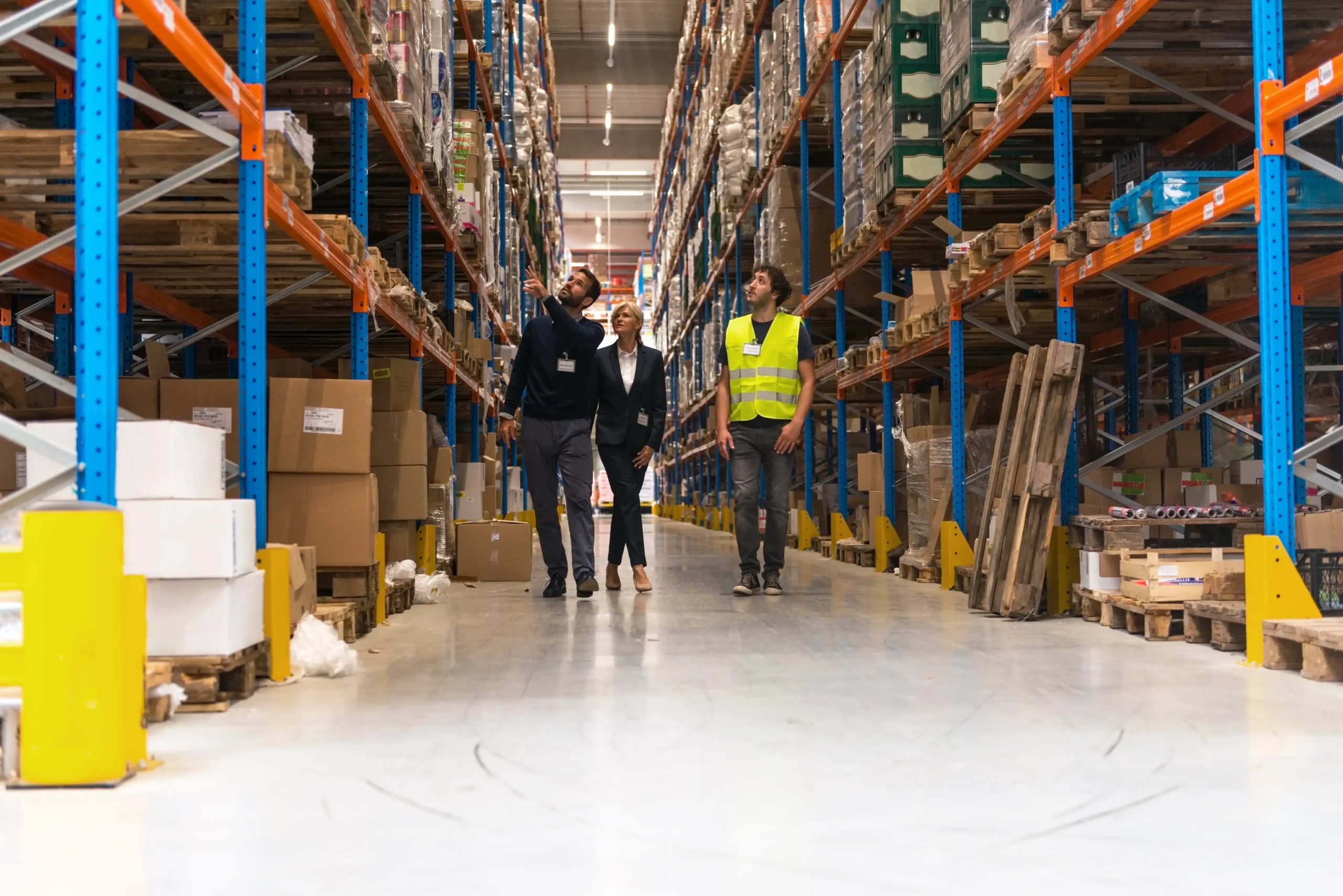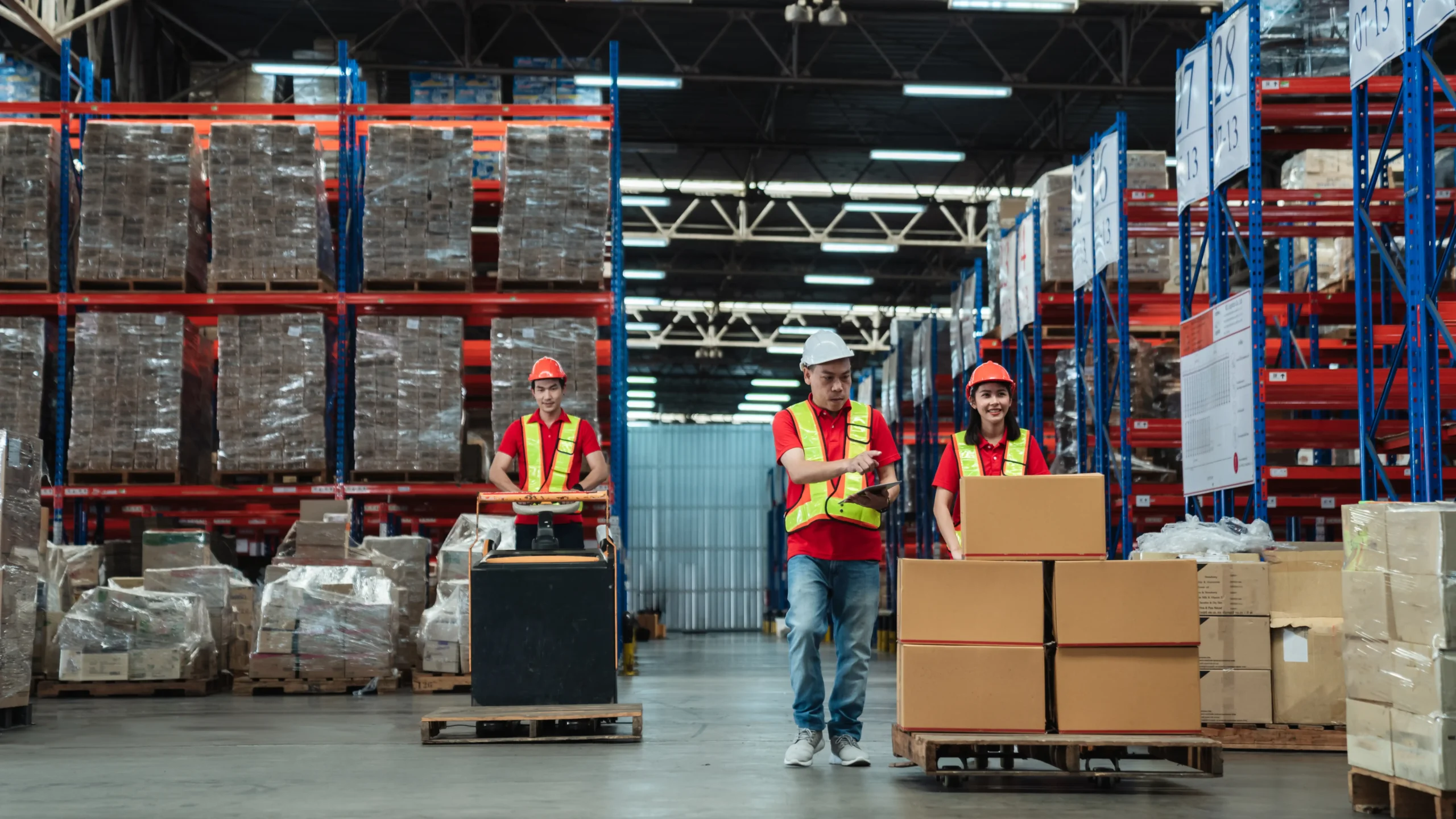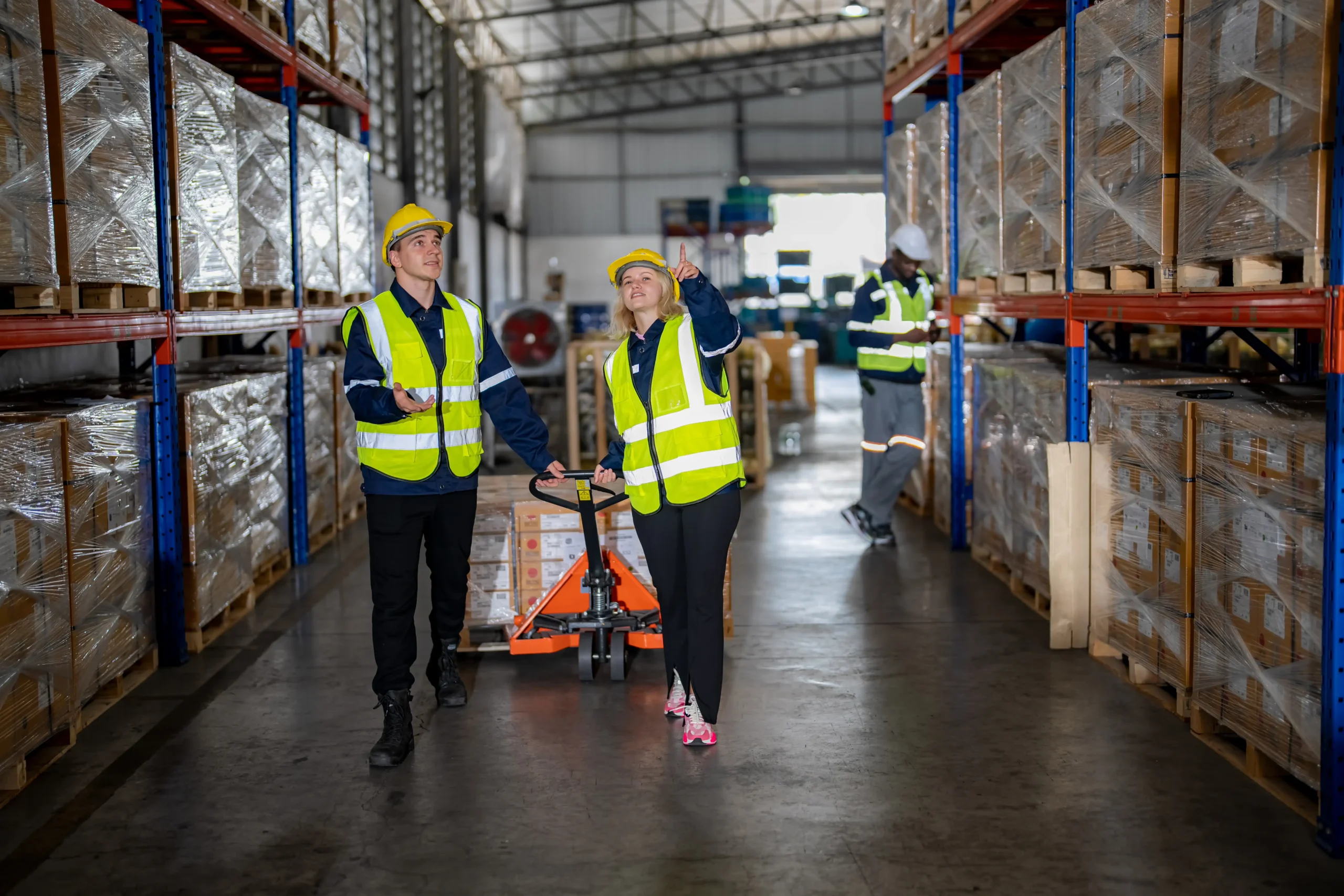Table of Contents
ToggleWarehouse logistics refers to the planning, operation, and management of goods within a warehouse to achieve business objectives. It includes organizing complex operations to maximize efficiency in storing, packing, and shipping goods.
As a 3PL and Foreign Trade Zone (FTZ) professional with over 35 years of experience, I’ve seen firsthand how crucial it is to have a solid warehouse logistics strategy. Not only does it ensure that products move smoothly from point A to point B, but it also plays a significant role in reducing operational costs and improving customer satisfaction.
At Tri-Link FTZ, we believe that understanding and implementing effective warehouse logistics is the backbone of any successful supply chain.

Warehouse logistics involves several key components that work together to streamline operations. One of the most critical elements is inventory management.
Keeping accurate, real-time records of inventory ensures that stock levels are optimized, reducing the risk of overstocking or stockouts. Proper inventory management also improves order fulfillment accuracy, which is vital for maintaining customer satisfaction.
Another essential component is the physical layout and design of the warehouse. A well-organized layout can significantly reduce the time it takes to pick, pack, and ship products, leading to faster delivery times and lower labor costs.
Technology plays a pivotal role in modern warehouse logistics. Implementing a Warehouse Management System (WMS) can automate many processes, from inventory tracking to order fulfillment.
At Tri-Link FTZ, we utilize advanced WMS to ensure that every aspect of our logistics operations is optimized for efficiency. Additionally, the human resources aspect cannot be overlooked.
Proper training and systematic labor allocation are crucial for maintaining high productivity levels and minimizing errors.
Reducing operational costs while maintaining efficiency is a common goal for many businesses. One effective strategy is to optimize inventory management. By using just-in-time inventory systems and accurate forecasting, businesses can minimize holding costs and reduce the risk of excess inventory.
At Tri-Link FTZ, we have seen how a well-implemented WMS can automate and streamline inventory processes, leading to significant cost savings. Another area where cost savings can be realized is in order fulfillment.
Efficient order processing, combined with accurate picking and packing, can reduce the time and labor required to fulfill orders. This not only lowers operational costs but also improves customer satisfaction by ensuring timely delivery.
Space utilization is another critical factor. By maximizing the use of available warehouse space through smart layout design and vertical storage solutions, businesses can reduce the costs associated with rent and utilities.
Outsourcing warehouse logistics to a Third-Party Logistics (3PL) provider like Tri-Link FTZ can also lead to cost savings. By leveraging our expertise and advanced technology, businesses can reduce the need for in-house logistics operations, allowing them to focus on their core business activities.
In today’s fast-paced business environment, technology is the driving force behind efficient warehouse logistics. Implementing a Warehouse Management System (WMS) is essential for any business looking to optimize its logistics operations.
A WMS provides real-time visibility into inventory levels, order processing, and shipment tracking, allowing for better decision-making and improved efficiency. Automation is another critical aspect of modern warehouse logistics.
By automating tasks such as picking, packing, and shipping, businesses can reduce labor costs and increase accuracy. At Tri-Link FTZ, we have integrated automation into our operations, resulting in faster processing times and fewer errors.
Additionally, the use of data analytics and business intelligence tools allows us to monitor key performance indicators (KPIs) and make data-driven decisions to continuously improve our logistics processes. The integration of mobile technology and IoT (Internet of Things) has further enhanced our ability to manage warehouse operations on the go.
These technologies provide real-time updates and allow for more efficient inventory management, reducing the risk of stockouts and improving overall efficiency. As sustainability becomes increasingly important, the use of green technology and energy-efficient practices is also becoming a key focus in warehouse logistics. Read more here.

While warehouse logistics offers many benefits, it also comes with its own set of challenges.Security management is a top concern, as protecting valuable inventory from theft or damage is critical to maintaining profitability.
Implementing robust security measures and using technology to monitor and track inventory can help mitigate these risks. Space constraints are another common issue, particularly for businesses with limited warehouse space.
Optimizing the warehouse layout and utilizing vertical storage solutions can help maximize the available space and improve operational efficiency. Climate control requirements are also a challenge, especially for businesses that store temperature-sensitive goods.
Maintaining the proper climate conditions in the warehouse is essential to preserving product quality and compliance with regulations. Additionally, regulatory compliance is a critical aspect of warehouse logistics that cannot be overlooked.
Ensuring that all operations comply with local, state, and federal regulations is essential to avoiding fines and maintaining a positive reputation. Another challenge is managing inventory variations, particularly when dealing with a wide range of products with different storage and handling requirements.
Using a WMS can help manage these variations and ensure that each product is stored and handled correctly.
The layout and design of a warehouse have a significant impact on warehouse logistics efficiency. A well-organized warehouse layout can reduce the time and labor required to pick, pack, and ship orders, leading to faster delivery times and lower operational costs.
At Tri-Link FTZ, we understand the importance of designing a warehouse layout that maximizes space and minimizes movement. By strategically placing storage areas, packing stations, and shipping zones, we can create a streamlined workflow that reduces errors and improves efficiency.
Space utilization is another critical factor in warehouse design. By utilizing vertical storage solutions and optimizing the use of available space, businesses can store more inventory without increasing their warehouse footprint.
This not only reduces costs but also improves overall efficiency. Safety and ergonomicsshould also be considered when designing a warehouse layout.
Ensuring that the warehouse is safe for employees and that ergonomic principles are applied can reduce the risk of accidents and injuries, leading to higher productivity and lower costs.
Outsourcing warehouse logistics to a Third-Party Logistics (3PL) provider can offer numerous benefits, especially for businesses looking to scale operations without the heavy investment in infrastructure. At Tri-Link FTZ, we’ve seen how partnering with a 3PL can lead to significant cost savings.
By leveraging our resources, businesses can avoid the substantial capital expenditures associated with owning and operating a warehouse. This includes costs related to staffing, technology, and ongoing maintenance.
Moreover, outsourcing allows businesses to tap into the scalability that 3PL providers offer. Whether your business experiences seasonal peaks or rapid growth, a 3PL provider can easily adjust to your changing needs, providing additional space, labor, and technology as required.
This flexibility means you can focus on growing your business while we handle the complexities of warehouse logistics. Another advantage is access to advanced technology.
At Tri-Link FTZ, we use cutting-edge WMS and automation tools that many small to mid-sized businesses might find cost-prohibitive to implement on their own. These technologies enhance accuracy, speed, and efficiency in warehouse operations, translating into better service for your customers and higher overall profitability.
By outsourcing, you also free up internal resources, allowing your team to focus on core business activities rather than being bogged down by logistics challenges. This improved focus often leads to better product development, marketing, and customer service, driving the business forward.
Lastly, outsourcing logistics to a 3PL provider like Tri-Link FTZ can improve risk management. With our expertise, we can help mitigate risks related to inventory, security, and regulatory compliance, ensuring that your operations run smoothly and without costly interruptions.
Our experience in handling diverse products and navigating complex regulations makes us a reliable partner in your logistics journey.

Incorporating sustainability into warehouse logistics is not only beneficial for the environment but also for your bottom line. Sustainable practices can reduce energy costs, minimize waste, and improve your company’s reputation.
At Tri-Link FTZ, we are committed to promoting energy-efficient solutions within our warehouse operations. This includes using LED lighting, optimizing HVAC systems, and implementing energy-saving technologies throughout our facilities.
Reducing waste is another critical aspect of sustainable warehouse logistics. By implementing recycling programs and using sustainable packaging materials, we can significantly cut down on the amount of waste generated in our operations.
Moreover, automating processes such as stock rotation not only improves efficiency but also reduces the likelihood of expired or damaged goods, further decreasing waste. Sustainable practices also extend to transportation and logistics.
By optimizing routes and utilizing energy-efficient vehicles, we can reduce the carbon footprint associated with the transportation of goods. This not only aligns with global sustainability goals but also improves overall logistics efficiency.
Finally, integrating sustainability into your supply chain can enhance your brand’s image and appeal to increasingly eco-conscious consumers. Customers are more likely to support businesses that demonstrate a commitment to environmental responsibility, making sustainability a competitive advantage in today’s market. Read more here.
Ensuring accurate and timely order fulfillment is a cornerstone of effective warehouse logistics. At Tri-Link FTZ, we prioritize precision in every step of the order fulfillment process.
This starts with order processing efficiency. By streamlining processes and utilizing automation, we can minimize errors and reduce the time it takes to process orders, leading to quicker shipping times and happier customers.
Accuracy in order picking is another critical area. Using advanced WMS and automation, we ensure that the right product is picked every time, reducing the risk of returns and increasing customer satisfaction.
This level of accuracy also contributes to cost savings, as fewer mistakes mean fewer resources spent on correcting errors. Timely shipping and delivery are also essential.
By optimizing our logistics processes, we ensure that orders are shipped and delivered as quickly as possible, meeting or exceeding customer expectations. This not only improves customer loyalty but also enhances our clients’ reputations for reliability.
Managing returns efficiently is another area where effective warehouse logistics can make a significant difference. A streamlined returns process that quickly addresses customer issues can turn a potentially negative experience into a positive one, further strengthening customer relationships.
Continuous improvement is key to maintaining high standards in order fulfillment. At Tri-Link FTZ, we regularly review our processes, analyze performance data, and implement improvements to ensure that our warehouse logistics operations remain at the cutting edge of efficiency and accuracy.
To ensure that warehouse logistics operations are performing optimally, it’s essential to measure and track key performance indicators (KPIs). At Tri-Link FTZ, we utilize advanced performance monitoring tools to keep a close eye on our logistics operations.
This allows us to identify areas for improvement and make data-driven decisions that enhance efficiency. KPIs such as order accuracy, inventory turnover, and shipping times provide valuable insights into how well the warehouse is performing.
By regularly reviewing these metrics, we can spot trends, address issues before they become major problems, and continuously optimize our operations. Continuous improvement strategies are central to our approach.
We believe that there is always room for enhancement, whether it’s through refining processes, adopting new technologies, or training our staff. This commitment to improvement ensures that our warehouse logistics operations are always evolving to meet the needs of our clients and the demands of the market.
Benchmarking against industry standards and setting ambitious yet achievable goals helps us stay ahead of the competition. By comparing our performance with industry leaders, we can identify best practices and implement them in our operations.
Finally, monitoring employee performance and productivity is crucial. Our team is at the heart of our logistics operations, and by ensuring they are well-trained and motivated, we can maintain high levels of productivity and efficiency across the board.
Share this article
We have other resources available upon request as well as one-on-one support and personalized answers, just like our services.
Simply contact us anytime and we’ll get back to you to answer your questions and provide meaningful answers that show you how Tri-Link supports your logistics, reduces costs, and accelerates efficiency.
Tri-Link delivers exceptional FTZ and 3PL services tailored to your global trade needs.
Our solutions combine innovation, quality, and efficiency to exceed your expectations and meet your specific requirements.